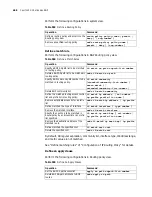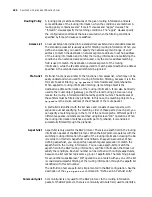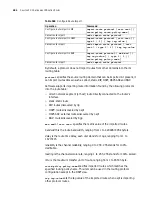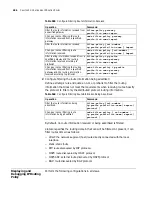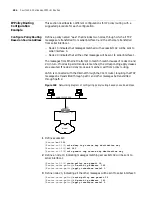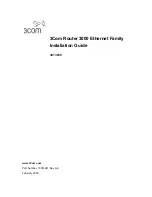
480
C
HAPTER
31: C
ONFIGURING
IP R
OUTING
P
OLICY
Routing Policy
A routing policy matches attributes of the given routing information and sets
some attributes of the routing information when the conditions are matched. A
routing policy contains several "if-match" clauses and "apply" clauses. The
"if-match" clauses specify the matching conditions. The "apply" clauses specify
the configuration commands that are executed when the filtering conditions
specified by if-match clauses are satisfied.
Access List
An access list can be divided into a standard access list and an extended access list.
The standard access list is usually used for filtering routing information. When you
define an access list, you need to specify the network segment range of an IP
address, to match the destination network segment address or next hop address
of the routing information and to filter the routing information not satisfying the
conditions. If an extended access list is used, only the source address matching
field is used to match the destination network segment of the routing
information, while the IP address range used to match packet destination address
specified in the extended access list should be ignored.
Prefix-list
Prefix-list functions are similar to the functions of an access list, which may not be
easily understood when used for routing information filtering, because it is in the
format of packet filtering.
ip ip-prefix
is more flexible and comprehensible.
When applied to routing information filtering, its matching object is the
destination address information of the routing information. It can also be directly
used to the router object (gateway), so that the local routing protocol can only
receive the routing information distributed by specific routers. The addresses of
these filters must be filtered by prefix-list. In this case, the matching object of
ip
ip-prefix
is the source address of the IP header of the route packet.
A prefix-list is identified with the list name and consists of several parts, with
sequence-number
specifying the matching order of these parts. In each part, you
can specify a matching range in the form of the network prefix. Different parts of
different
sequence-numbers
are matched using Boolean “OR” operations. When
the routing information matches a specific part of
prefix-list
, it is considered
successfully filtered through the
prefix-list
.
Aspath-list
Aspath-list is only used for the BGP protocol. There is an aspath field in the routing
information packet of the BGP protocol. When the BGP protocol operates with the
switching routing information, the path of the routing information crossing the AS
is recorded in this field. Aspath-list is identified with
aspath-list-number.
When
defining aspath-list, you can specify an aspath regular expression to match the
aspath field in the routing information. You can use aspath-list to match the
aspath field in the BGP routing information, and filter information that does not
satisfy the conditions. Each list number can be defined with multiple aspath-lists,
because one list number represents a group of aspath-lists. The matching process
for
acl-number
s uses Boolean “OR” operations, so a match with any one of the list
is considered successful filtering of the routing information through the aspath list
identified with this list number.
The definition of
access-path-list
is implemented in the BGP configuration. See the
description of the
ip as-path acl
command in “Define an AS Path-list entry”.
Community-list
Community-list is only used for the BGP protocol. In the routing information
packet of the BGP protocol, there is a community attribute field, used to identify a
Summary of Contents for 3036
Page 1: ...http www 3com com 3Com Router Configuration Guide Published March 2004 Part No 10014299 ...
Page 4: ...VPN 615 RELIABILITY 665 QOS 681 DIAL UP 721 ...
Page 6: ...2 ABOUT THIS GUIDE ...
Page 7: ...I GETTING STARTED Chapter 1 3Com Router Introduction Chapter 2 3Com Router User Interface ...
Page 8: ...4 ...
Page 16: ...12 CHAPTER 1 3COM ROUTER INTRODUCTION ...
Page 34: ...30 ...
Page 60: ...56 CHAPTER 3 SYSTEM MANAGEMENT ...
Page 98: ...94 CHAPTER 6 DISPLAY AND DEBUGGING TOOLS ...
Page 110: ...106 ...
Page 114: ...110 CHAPTER 8 INTERFACE CONFIGURATION OVERVIEW ...
Page 158: ...154 CHAPTER 10 CONFIGURING WAN INTERFACE ...
Page 168: ...164 ...
Page 188: ...184 CHAPTER 13 CONFIGURING PPPOE CLIENT ...
Page 192: ...188 CHAPTER 14 CONFIGURING SLIP Router ip route static 0 0 0 0 0 0 0 0 10 110 0 1 ...
Page 248: ...244 CHAPTER 16 CONFIGURING LAPB AND X 25 ...
Page 320: ...316 ...
Page 330: ...326 CHAPTER 20 CONFIGURING IP ADDRESS ...
Page 362: ...358 CHAPTER 21 CONFIGURING IP APPLICATION ...
Page 374: ...370 CHAPTER 23 CONFIGURING IP COUNT ...
Page 406: ...402 CHAPTER 25 CONFIGURING DLSW ...
Page 408: ...404 ...
Page 452: ...448 CHAPTER 29 CONFIGURING OSPF ...
Page 482: ...478 CHAPTER 30 CONFIGURING BGP ...
Page 494: ...490 CHAPTER 31 CONFIGURING IP ROUTING POLICY ...
Page 502: ...498 ...
Page 508: ...504 CHAPTER 33 IP MULTICAST ...
Page 514: ...510 CHAPTER 34 CONFIGURING IGMP ...
Page 526: ...522 CHAPTER 36 CONFIGURING PIM SM ...
Page 528: ...524 ...
Page 532: ...528 CHAPTER 37 CONFIGURING TERMINAL ACCESS SECURITY ...
Page 550: ...546 CHAPTER 38 CONFIGURING AAA AND RADIUS PROTOCOL ...
Page 590: ...586 CHAPTER 40 CONFIGURING IPSEC ...
Page 599: ...IX VPN Chapter 42 Configuring VPN Chapter 43 Configuring L2TP Chapter 44 Configuring GRE ...
Page 600: ...596 ...
Page 638: ...634 CHAPTER 43 CONFIGURING L2TP ...
Page 649: ...X RELIABILITY Chapter 45 Configuring a Standby Center Chapter 46 Configuring VRRP ...
Page 650: ...646 ...
Page 666: ...662 ...
Page 670: ...666 CHAPTER 47 QOS OVERVIEW ...
Page 700: ...696 CHAPTER 49 CONGESTION MANAGEMENT ...
Page 706: ...702 CHAPTER 50 CONGESTION AVOIDANCE ...
Page 707: ...XII DIAL UP Chapter 51 Configuring DCC Chapter 52 Configuring Modem ...
Page 708: ...704 ...
Page 762: ...758 CHAPTER 52 CONFIGURING MODEM ...



